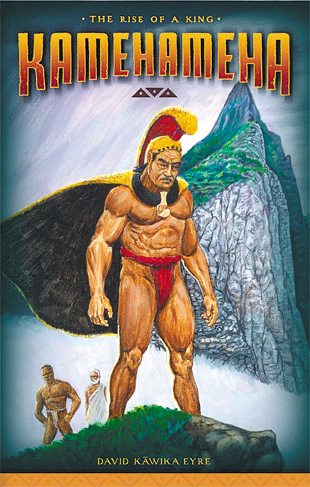Book Gives Life To Hawaiian History
“It was a time of many prayers, some of life, some of death. Kokoiki at Kohaha was the place, and the month was ‘Ikuwa. Men’s thoughts were of war and sea and storm. An astonishing star streamed across the northern sky. People pointed and exclaimed, “A white rainbow!” It was the unmistakable sign of a great chief’s birth.”
The very first paragraph of Kamehameha: The Rise of a King had me enthralled. It’s a riveting read, a great story and — dare I say it — an important book that should be assigned to every schoolkid in Hawaii.
David Kawika Eyre, a teacher of Hawaiian language for 23 years at Kamehameha Schools, looked at what his students were reading and at the role models that were placed before them.
He found them lacking. There was nothing in the American education system that spoke to the children of Hawaii, “the native child, dark-skinned child, white child, Hawaii child, any kine child, is not seeing himself/herself in the words and images and themes and vocabulary of our textbooks and story books.”
During a lunch with Joseph Campbell and Jean Erdman in the late 1980s, Campbell “pointed his fork my way and asked: ‘You’re a teacher. Why don’t we hear much about the heroes of Hawaii? Why aren’t our children told the stories of the heroes of this land?’ That of course planted a seed.”
And the result is this exceptional book.
Eyre, as a writer of historical fiction, emphasizes the history part of the equation without sacrificing the human elements of storytelling that bring the characters to life.
The book starts strong, catapulting us into the drama of Kamehameha’s birth and how he was whisked away, hidden beneath a cloak from the chiefs who wanted the baby dead.
I loved the chapter on his early childhood in the safe haven of Halawa, titled “Lumpy Poi and Twisting Eels.” We learn that, blessed as he was with size, physical strength and keen intelligence, he was still a boy who had to be taught about the value of work, decency and what it means to be a simple child of the land.
It was here among the farmers, fishermen and families who accepted him as one of their own, nurtured and protected him, that Kamehameha found the part of his humanity that shaped his thinking as a warrior, a unifier and a leader.
One of the most intriguing chapters deals with the arrival of Captain Cook. When all his people believed this strange white being with glittering eyes was the great god Lono, Kamehameha was skeptical from the first.
“He didn’t just bow down and take it at face value that this was Lono,” Eyre says. “It became apparent to him very early on that there were things missing in this situation.
“My take as the writer here is that Kamehameha asked pretty probing questions. Lono is the god of fertility and peace. This guy doesn’t speak our language, the people who serve him are not healthy. He’s moody, he doesn’t understand our culture. Kamehameha figured this out real soon.”
One of Kamehameha’s many legacies — perhaps his greatest — was his “Law of the Splintered Paddle.”
The story is, Kamehameha, desperate for victory in war, needed to sacrifice a few innocents in order to gain the favor of the gods. He went to Puna, where men, women and children saw him and were afraid. Kamehameha chased down two fishermen, intent on killing them. Instead, he fell into a lava pit and was trapped. One of the fishermen bashed him on the head with his wooden paddle, grievously injuring Kamehameha. As he lay near death for months, he had his epiphany.
“Kamehameha was having an existential crisis,” Eyre says. “Everything was called into question for him. He went out and he did something that he later figured was wrong. But by Hawaiian cultural standards, it wasn’t wrong. He was the ali’i. He had every right to do what he wanted to do to a commoner, right? And he had every right to send his warriors to get those guys who whacked him on the head and kill them.”
But Kamehameha did not have them killed. What he did instead was remarkable, says Eyre.
“He finally said, ‘Hey. No’u ka hewa. The mistake was mine.’ And for an ali’i to say that, that’s pretty astounding.”
And then he uttered the famous Law of the Splintered Paddle, which, in a nutshell, protects the weak from the strong, the helpless from the powerful. It demands respect alike for both chief and commoner.
That was pretty radical for its time.
“For me,” says Eyre, “that’s the affirmation of who he is as a much more complex human being, struggling with deep issues. Fairness. Pono, as we say in Hawaiian. What is right and what is wrong? How do we treat each other?”
Kamehameha: The Rise of a King is available at Costco, Target and local bookstores as well as Amazon.com.
Get it. Read it. I give it two thumbs up.
jmoonjones@aol.com
Twitter: @JadeMoon1






